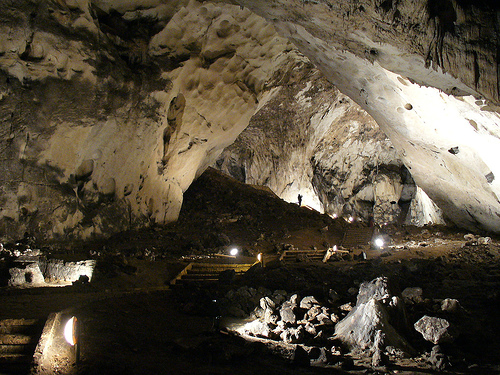

Location: Rabisha, Vidin Province Map
Total length: 2.5 km (1.5 mi)
Official site
Magura Cave is situated near village of Rabisha and 18 km from
Belogradchik in the North West Bulgaria. It is one of the
largest and most interesting underground systems in Bulgaria. It
consists of the main gallery and three side tunnels at an
overall length of 2500 meters in length. Magura Cave was formed
at least 15 millions years ago and the process of geologic
erosion continues to this day.
Magura Cave is famous for
its prehistoric cave art and remains of the human occupation
since late Epipaleolithic Age and Neolithic Age. It depicts
various scenes from lives of ancient people including hunters on
hunting trails, people dancing, various animals and other things
that were important for the residents of the Magura Cave.
Additionally archeologists who dug in the area discovered one of
the oldest solar calendars ever to be discovered in Bulgaria and
overall Europe. Apparently ancient people held five important
festivals over a course of a year that ancients believed lasted
366 days. Given the age of the Magura Cave finding it is amazing
that they managed to keep such a good record of the astronomical
progression of the year.
Judging by animal remains cave
hyenas and cave bears frequently stayed in Magura Cave for
shelter and security. Humans it seems had a different idea of
who is to own this nice piece of property. They managed to
establish a permanent settlement and depict scenes from their
daily lives as well as religious ceremonies. The cave was
abandoned in favor of more comfortable living in houses, but we
have evidence that people often ventured and explored the cave
in the Roman times as well as medieval. It takes about 5 hours
to explore 3 km (2 mi) of the total length. Temperature here
stays at 12 C or 56 F all year round so you might want to take
some warm cloths with you. This unique microclimate allows parts
of the cave to be used as a storage for local wines. Magura's
largest room is used occasionally for concerts.
Location
It is located on the southern slope of
the karst hill Rabishka Mogila, Western Fore-Balkans. It is located
about 18 km northwest of the town of Belogradchik and about 1.5 km
northwest of the village of Rabisha.
Detection and research
It is formed by karst processes in thick-layer bottom-bed gray-white
limestones. It is one of the largest Bulgarian caves. Its exit is
called the Gatekeeper. Some halls are colossal in size. Separate
halls are the Triumphal Hall, the Field, the Harmana, the Bat
Gallery, the Shooting Range, the Picture Gallery, the Ominous
Gallery, the Sun Hall, the Stalacton Hall, the Fallen Pine Hall, the
Poplar Hall, the Throne Hall. All halls are connected by galleries
and cave tunnels, there are many stalactites, stalagmites and
stalactons, and in the Triumphal Hall there is a small lake. Magura
has a constant temperature of 12 ° C. The total length of its
galleries is 2500 m.
Bones of a cave bear, a cave hyena and
others were found in the cave. On the walls you can see paintings
from several historical epochs, made with guano (bat manure). The
earliest drawings are from the Late Paleolithic, as well as from the
Neolithic; the most recent are from the Bronze Age and were painted
between 3000 and 1200 BC. The drawings depict mainly hunting scenes,
a solar-lunar calendar, a fertility scene and individual drawings.
Some are relief - due to the natural erosion of the rock below them.
The imported microorganisms from the external environment, the
constant lighting (due to which mold is formed) and the intervention
of the people destroy most of the paintings and for a long time this
gallery was closed.
Bats in the cave
Magura is the most
important cave for bats in all of Northwestern Bulgaria. It is
inhabited all year round by a total of 8 species, all priority for
conservation throughout Europe:
Great horseshoe bat (Rhinolophus
ferrumequinum)
Small horseshoe bat (Rhinolophus hipposideros)
Southern horseshoe bat (Rhinolophus euryale)
Myotis emarginatus
Myotis myotis
Nightingale (Myotis blythii)
Long-toed
nightingale (Myotis capaccinii)
Myotis bechsteinii
The
long-toed nightingale and southern horseshoe bat found in the cave
are included in the World Red List. In addition to more than 2,000
wintering bats of several species, a colony of more than 450 small
horseshoe bats has been registered here during the winter - a record
number for the country. On the upper floor above the Concert Hall
(inaccessible without the use of speleo-techniques) there is a
horizontal, dry gallery, where large summer colonies of several
species breed.
Tourism
The cave is a national tourist site
- №14 of the Hundred National Tourist Sites.
On May 3, 1960, the
cave and the area around it with an area of 71 hectares were
declared a natural landmark.
The largest inland, tectonic lake in
Bulgaria is located near the cave - Rabishkoto Lake.
The branch
of the cave produces sparkling wine due to the ideal conditions -
very close to those in the Champagne region.